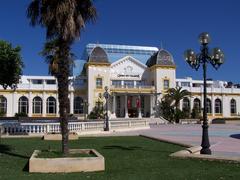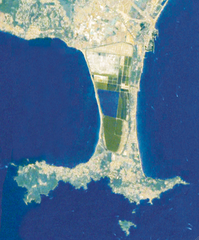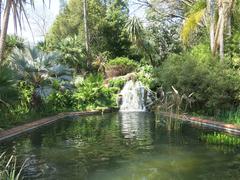
Visiting Guide for Route du Sel in Hyères, France
Publication Date: 01/08/2024
Introduction to Route du Sel
The Route du Sel in Hyères, France, is a destination that seamlessly blends rich historical significance with diverse ecological value. Nestled between the Mediterranean Sea and coastal lagoons, this unique site offers visitors an unparalleled experience of marine and terrestrial ecosystems. The area’s history dates back to antiquity, with salt production being a pivotal activity for early settlers, including Greek sailors around 400 BC and Romans who harvested salt extensively (Tourisme Varois). Although salt production ceased in 1995, the historical salt pans have been preserved and now serve as important habitats for wildlife. This historical backdrop enriches the area’s cultural heritage and adds to its allure. Beyond its historical significance, the Route du Sel is characterized by a mosaic of habitats that support a rich array of flora and fauna, making it a biodiversity hotspot. This guide will provide you with a comprehensive overview of the Route du Sel, including its history, ecological importance, visitor information, and travel tips to ensure a memorable visit.
Table of Contents
- Introduction to Route du Sel
- Historical Significance
- Ecological Importance
- Visitor Information
- Visitor Guidelines
- Educational Programs
- Research and Monitoring
- FAQ
- Conclusion
Historical Significance
Ancient Beginnings and Greek Influence
The history of the Route du Sel in Hyères is deeply intertwined with the ancient practice of salt extraction, which dates back over two millennia. The region’s strategic location and abundant natural resources made it an attractive site for early settlers. Around 400 BC, Greek sailors were among the first to recognize the value of the salt marshes.
Roman Era and Salt Production
The Romans also played a significant role in salt production, referring to it as ‘white gold,’ which was used as a preservative and currency. Although salt production ceased in 1995, the historical salt pans have been preserved and now serve as important habitats for wildlife (Tourisme Varois).
Ecological Importance
Unique Ecosystems and Biodiversity
The Route du Sel is characterized by a mosaic of habitats, including salt marshes, temporary ponds, and saline soils known as sansouires. These environments support a rich array of flora and fauna, making it a biodiversity hotspot. Halophyte plants in the salt marshes play a crucial role in regulating soil salinity and serve as breeding grounds for various invertebrates, supporting higher trophic levels, including numerous bird species.
Avian Diversity
This area is a critical stopover for migratory birds, offering a haven for resting and feeding. Species such as flamingos, stilts, and sandpipers are commonly observed here. During the winter months, the marshes host various species of ducks and cormorants. The salt marshes also provide breeding grounds for gulls and terns (La Pascalinette).
Protected Species
The Route du Sel is home to several protected species, including the ocellated lizard, the largest lizard in Europe, and the Hermann’s tortoise. These species benefit from the protected status of the area, ensuring their survival in the face of habitat loss and other threats (Tourisme Varois).
Visitor Information
Route du Sel Visiting Hours and Tickets
The Route du Sel is accessible year-round, but visiting hours may vary depending on the season. It’s advisable to check the official website or local tourist information centers for the most up-to-date visiting hours. There is no entrance fee, making it an ideal destination for budget-conscious travelers.
Travel Tips
Visitors are encouraged to stay on designated trails and avoid disturbing wildlife. Using the ‘Hyères plages’ app can help you find suitable beaches and recreational areas. Wearing comfortable walking shoes and bringing binoculars for bird-watching can enhance your experience.
Nearby Attractions
In addition to exploring the Route du Sel, visitors can enjoy nearby attractions such as the Port-Cros National Park and the historic town of Hyères. These sites offer additional opportunities for nature exploration and cultural experiences.
Accessibility
The Route du Sel is accessible by car, with parking available near the entrance. Public transportation options are also available, with regular bus services from Hyères. The trails are well-marked and suitable for visitors of all ages.
Special Events and Guided Tours
Organizations such as the Ligue pour la Protection des Oiseaux (LPO) offer guided tours, providing an educational experience about the area’s ecological significance. Special events, including bird-watching days and conservation workshops, are held throughout the year.
Photographic Spots
The Route du Sel offers numerous photographic spots, especially for capturing stunning images of migratory birds and the unique landscapes of salt marshes and lagoons.
Visitor Guidelines
To protect the delicate ecosystems, visitors should adhere to guidelines such as staying on trails, not picking plants, and avoiding disturbing wildlife. These measures help ensure the preservation of the area for future generations.
Educational Programs
Educational programs and workshops are regularly organized to engage the public and foster a deeper understanding of the ecological importance of the Route du Sel. These programs cover topics such as the role of salt marshes in the ecosystem and the history of salt production in the region (Tourisme Varois).
Research and Monitoring
Ongoing research and monitoring are essential for the effective management of the Route du Sel. Scientists and conservationists conduct regular surveys to track the health of the ecosystems and the populations of various species. This data informs conservation strategies and ensures the area remains a thriving habitat for wildlife.
FAQ
Q: What are the visiting hours for Route du Sel? A: Visiting hours vary by season. Check the official website or local tourist information centers for the latest information.
Q: Is there an entrance fee for Route du Sel? A: No, there is no entrance fee.
Q: Are guided tours available? A: Yes, guided tours are offered by organizations such as the Ligue pour la Protection des Oiseaux (LPO).
Q: What should I bring for my visit? A: Comfortable walking shoes and binoculars for bird-watching are recommended.
Conclusion
The Route du Sel in Hyères is a prime example of how historical and ecological significance can coexist, offering a unique destination for ecotourism. Its diverse ecosystems, rich biodiversity, and ongoing conservation efforts make it a must-visit for nature enthusiasts. By following visitor guidelines and participating in educational programs, visitors can contribute to the preservation of this ecological gem for future generations. For more information, download the ‘Hyères plages’ app, check out related posts, or follow us on social media for updates (La Pascalinette).
References and Further Reading
- Tourisme Varois. Les Vieux Salins d’Hyères: Mémoire Saline Face aux Palmiers Ondulant. https://www.tourisme-varois.com/les-vieux-salins-dhyeres-memoire-saline-face-aux-palmiers-ondulant
- La Pascalinette. Les Salins d’Hyères: En. https://www.lapascalinette.com/our-favorite-places/les-salins-dhyeres-en/
- Weather2Travel. Hyères Weather. https://www.weather2travel.com/france/hyeres/
- TripHobo. La Route du Sel. https://www.triphobo.com/places/hy-res-france/la-route-du-sel








